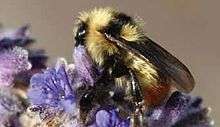Bombus centralis
Bombus centralis, the central bumblebee, is a species of bumble bee found in parts of Canada and the western United States.[2][3]
| Bombus centralis | |
|---|---|
 | |
| Queen | |
| Scientific classification | |
| Kingdom: | Animalia |
| Phylum: | Arthropoda |
| Class: | Insecta |
| Order: | Hymenoptera |
| Family: | Apidae |
| Genus: | Bombus |
| Subgenus: | Pyrobombus |
| Species: | B. centralis |
| Binomial name | |
| Bombus centralis | |
Description
Bombus centralis is a small bumblebee with a long face and proboscis[2] and light brown wings. The queen has a body length between 12.5 and 16 mm (0.49 and 0.63 in) and a wing span of 29 to 33 mm (1.1 to 1.3 in); the males have a length of 10 to 13 mm (0.39 to 0.51 in) and a wing span of 22 to 29 mm (0.87 to 1.14 in), while the workers are 9.5 to 12.5 mm (0.37 to 0.49 in) in length with a wing span of 23 to 28 mm (0.91 to 1.10 in).[4] The colouration of the thorax and anterior part of the abdomen is yellow, while terga (abdominal segments) 3 and 4 (for the females) and 3 to 5 (males) are orange-red. The tail is black; overall the hair is long. Across the thorax is a black, medially located band.[2]
Distribution
The species is distributed from British Columbia and Alberta in Canada to California, Arizona and New Mexico in the United States.[3]
Ecology
The bumblebee lives in prairies or river valleys. The hibernating queens appear in late May and start building a nest, often in disused rodent nests. About a month later, the first workers emerge. The nest declines in September, and all the bees, except the new queens, die.[4] The bees forage on various plant taxa, such as wild onions, rabbitbrush, thistles, goldenbushes, coyote mints, penstemons, and phacelias.[1]
References
| Wikimedia Commons has media related to Bombus centralis. |
- Hatfield, R., et al. 2014. Bombus centralis. The IUCN Red List of Threatened Species. Downloaded on 04 March 2016.
- Jonathan Koch, James Strange & Paul Williams (2012). "Bumble Bees of the Western United States" (PDF, 7.56 MB). The Xerces Society. pp. 34–37. Retrieved 30 January 2013.
- "North American bumblebees". Bumblebee.org. Retrieved 2013-01-26.
- "Bombus centralis". Strickland Entomological Museum, University of Alberta. Retrieved 2013-01-30.
